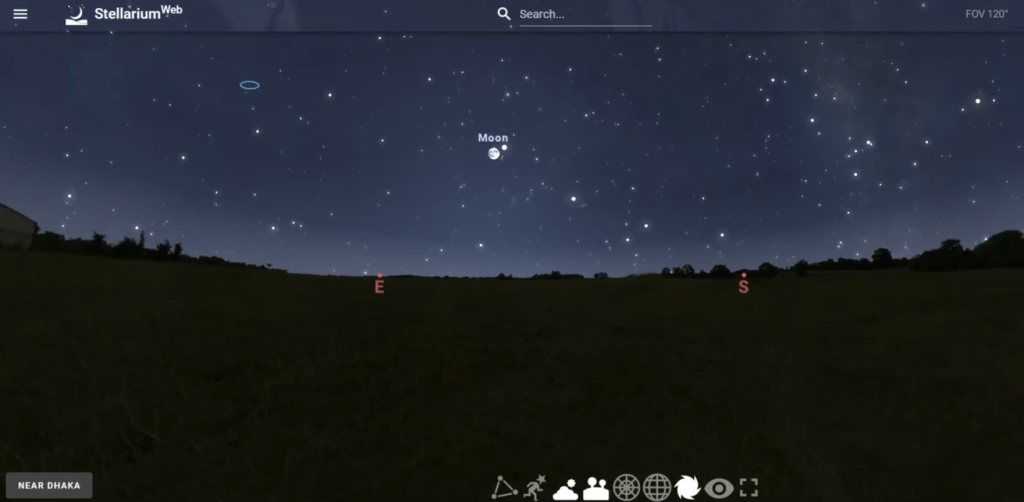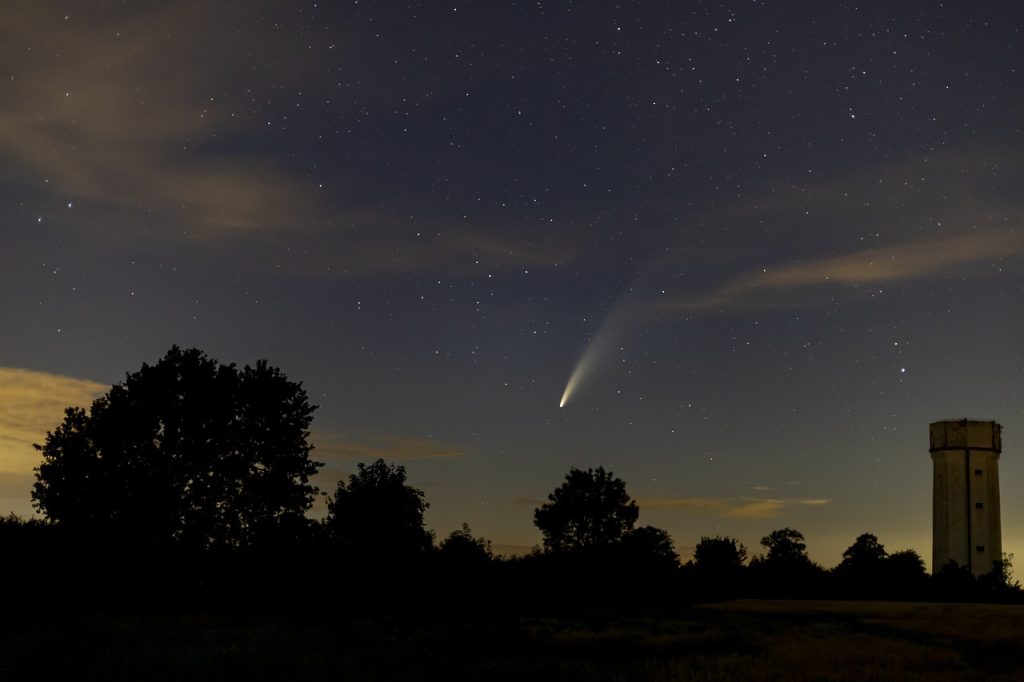Stellarium is an app, and its online version is available on the web, which I am showing you now. The mobile application version is available on both the Google Play Store and the iPhone App Store. This tutorial will help you learn about Stellarium’s working procedure.
Finding Milky Way
Through this app, you can easily track the Milky Way. After opening this software, you will see detailed information about what objects are present in the night sky. The app shows the time and date section on the bottom right side, and if you click on the “Back to Real Time” option, it will switch to real-time.
So, this is now showing in real-time. If you look closely at this photo, it shows the core of the Milky Way is positioned between the South and West. To see the core of the Milky Way, you must go to a dark location during specific seasons when the sky is completely clear, and there’s no moon in the sky.

However, atmospheric conditions play a role, and due to the atmosphere today, the Milky Way might not be visible. When you’re trying to photograph stars, you need to keep light pollution in mind. I will explain why later. But if I turn off the atmospheric effect in the app, you can clearly view the core of the Milky Way here.
In the next picture, you can see the East is on the left and the South is on the right. The moon is located towards the eastern part of this picture.

We know that light reflects from the moon, right? The light from the moon reflects and falls over the entire Earth. If you think of the moon as a headlight, the amount of light falling on Earth from it is so much that the light from distant stars, even those in the core of the Milky Way or elsewhere in the galaxy, becomes so faint that they can’t be seen.
Stellarium Star Map
Now, if I turn on the equatorial grid, then you can see that this is the north side, the sky above my northern direction. Look at this picture; you will be able to see the North Pole.

And on the exact opposite side, there is the South Pole, which is located below the south. Our Milky Way’s position at this time is between the south and the western sky. Since it’s positioned below the south, if I now turn on the landscape, you won’t be able to see the South Pole anymore.

So, the star trails from the South Pole, this type of photo is not possible from my country; I have to capture it from the North Pole. If I go to the north, you will see that the position is much higher in the landscape.

If I zoom in, suppose you are doing mobile photography, then you might get a very wide shot like this. In this frame, you will notice that there are many stars around the polar area.

Using Stellarium to Get Star Trails
If you can find a very dark location from where you can see the stars clearly towards the north, then you can capture these star trails. I am able to capture a full ring image from my country if I select the North Pole. But if I try in the South Pole, I won’t be able to access it because it’s below the horizontal line of the landscape. I won’t be able to capture a complete ring.
To capture a complete ring, normally, I shoot for about three to four hours. You can see it in Stellarium by dragging and rotating the ring. If you shoot for a particular time, you will get a lot of star movement in your frame. Though completing the entire ring is not necessary.
The other thing is that you need to take many photos. If you take a minimum of 200-300 pictures with 32-second exposures, you can get the result. I think this is an interesting photo frame in astrophotography, where a full ring is visible in a picture, though it requires a lot of effort to capture. The ultimate result is much more interesting. And if you can add a subject, the photo will be even more beautiful.

With the Stellarium app, you can locate the stars in this way. As I mentioned, the South Sky, if you try to capture star trails there, the photo won’t be very good. An example of this is this picture. In this picture, I tried using my zoom lens, but as you can see, the movement of the stars is visible in the photos, but the trail is ruined because of the Milky Way’s core. The star concentration is so high that it’s impossible to bring it into the frame as a simple line. Instead, you see a mix of red, purple, and orange due to the high concentration of stars.

And ultimately, if you think about the star trail part, compared to these, this place looks much more colorful. If I count this image as a star trail photo, the middle part actually ruins the image. So, when the core of the Milky Way is present if you take a star trail photo, the actual quality of the photo won’t be beautiful — it won’t actually look good.
Tracking Stars in Stellarium
The astronomy app will help you easily track and find these stars. For example, look at the picture. Can you see the star named Vega? You can see that this is part of the Northern Constellation, and it is the brightest star in the Northern Constellation. Yes, this is one of the stars you can see in the night sky. If I talk about two stars, this is one of them, which is not in our galaxy but is very far away, and it gives out a lot of light.

If I go towards the South Pole, you will see another star here. This star is called Sirius. However, this star is very easily visible to the naked eye in the night sky. It is the brightest star in the night sky, apart from the Sun, of course. The Sun is in our solar system, but if we talk about the stars outside of our solar system, then Sirius is the brightest star in the night sky. It is located in the Southern Hemisphere.

So, if you want to take a picture of a star or a planet specifically, it’s important to know this information. Your requirements are to know which star or planet you will photograph and at what time it will be in which position according to your location. You can easily find information from this stargazing app. Stellarium web version is slower than the apk. So, I recommend you to try the apk version.
Viewing Planet in Stellarium
Speaking of planets, Mars, Saturn, and Jupiter are the brightest planets in our sky. Among these, Jupiter is the brightest. Venus and Jupiter both have very high brightness. Sometimes, Saturn’s pictures are possible, especially if you try with a 300mm lens. I was able to capture a picture of Saturn with my lens, but it wasn’t in the best condition. Since there was a lot of fungus on my lens, the images showed many problems and spots. But even with that, I was able to take this picture of Saturn.

Milky Way Stacking
When I took this photo, I didn’t really have any idea about stacking, so I only took a single exposure. If I had taken multiple exposures and stacked them, the ring of Saturn would have been more visible and would have looked even better. But I didn’t know about stacking at that time. I took a single exposure and zoomed in. I think I zoomed in about 300%, and I got this frame.
Another picture I took was with the Moon. It was a constellation, and this is possibly either Jupiter or Venus. I didn’t pay attention to the exact star, but three moons of the planet were visible in the picture. Even though Venus’s actual color isn’t visible here, it appears very bright. If you take the picture with less light, Venus wouldn’t be visible. Therefore, I used my camera and lens to make it as visible as possible and took this picture.

This is a frame of the Moon, and the frame with the Moon is separate. So, I merged the two pictures to create a version that gives a more realistic vibe. The actual position of the planets was like this, and I added the images of the Moon and planets together to create that realistic feel. So, if you want, you can try planet photography with a 300mm lens. If you take multiple pictures and apply stacking, you can get better pictures.
The sky must be clear when taking pictures of stars at night. The Milky Way’s core will not be visible if the sky is not completely clear. Clouds in the sky may reduce the visibility of the stars. You can also try taking pictures of buildings or the Moon or other stars on a clear night and use the stacking option to enhance the result.
For example, such pictures can’t be taken in a single exposure. You would need to do a lot of work. Specifically, in this picture, the star trails you see in the background were created by stacking many photos together.

This type of picture cannot be taken with a single exposure because the foreground and background require different settings to capture the picture. The foreground was shot with one set of settings, and the background was shot with another setup. So, two photos were merged together to create one frame, and these are acceptable and actually look beautiful.
If you’re taking pictures, think about where you’ll take them. It’s essential to plan your location. Another benefit is when there’s a power outage in your area. During load shedding, all the lights are off, which can be a huge benefit for photography. Because the effect of the streetlights will be minimal. The Milky Way core will be evident, and the visibility of the stars will be much higher. The digital noise is also less in the dark areas.
FAQ
What is light pollution?
Light pollution happens when another light source reduces the visibility of the subject you’re trying to capture. Due to atmospheric conditions, the Milky Way won’t be visible. The reason for this is light pollution.
How to find galaxy in Stellarium?
If you search for M31 in Stellarium, you will see the location of this galaxy here. The same thing can be done on a mobile app, no problem at all.

If I zoom in on M31, you’ll see that it looks like this.

Our Milky Way galaxy looks similar, but we are inside the Milky Way, on a planet, so we won’t be able to capture a photo like this of our own Milky Way. It’s not possible. M31 (Andromeda Galaxy) is the closest galaxy to us, at a distance of approximately 25 million light years. And the M33 galaxy is also in the Andromeda group, and it’s the second closest galaxy to us. The distance from Earth to M33 is about 273 million light years.
How to find comet in Stellarium?
When comets come close to Earth, they become visible in photos. Unfortunately, comets are very rarely visible. Comets are visible from Earth around a specific time. If you take a picture of it at the right time, you can create this type of frame. You can search for a specific comet’s location or any planet or star’s location using this app.
